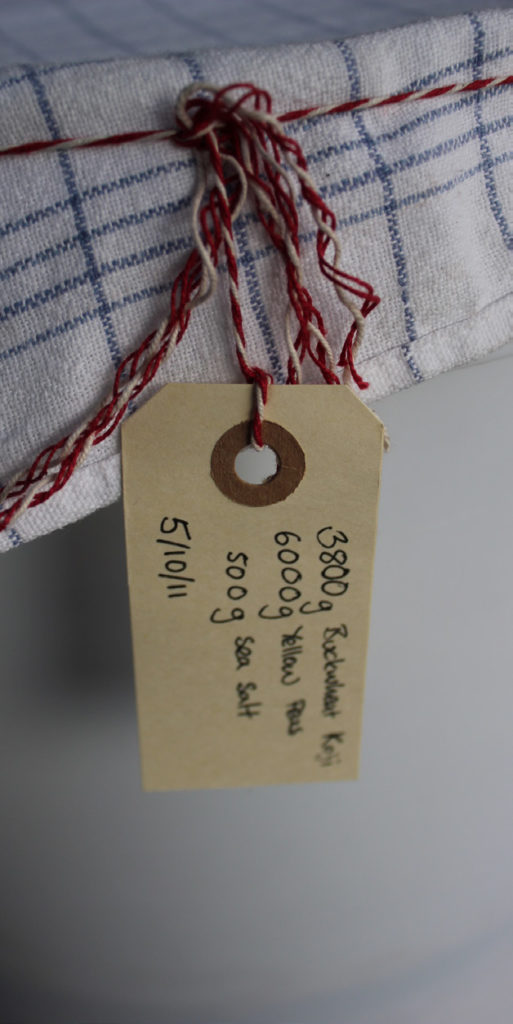by Ben Reade.
One really interesting project going on at the moment is the development of new recipes of miso. In Japan, miso is served at every meal, it is something with highly localised recipe variations where principle ingredients, normally rice, soya beans (or another legume) and sometimes barley are put to ferment in varying proportions with salt. There are two main parts of the fermentation. The first part in the Japanese technique revolves around the production of Koji, a traditional system of cultivating mold on steamed rice for the enzymes and particular flavour it produces.
When these molds have really taken hold of the rice, this ‘koji’ is mixed with salt, cooked soya beans, and possibly cooked barley. The second fermentation occurs at this point, in the presence of salt the molds die and the enzymes they have produced continue breaking down the various carbohydrates and proteins in the rice. This breakdown of larger molecules makes loads of free nutrients which can be further metabolized by lactic acid bacteria. These are really good bacteria, the kind that makes natural live yogurt so healthy.

As we want to get away from reliance from foreign products are in the process of adapting the recipe using locally available ingredients. We are growing our koji on steamed buckwheat, and mixing it with yellow split peas. The miso which comes out is a wondeful light colour similar to that of Japanese shiro miso. The delicate umami and salty tastes, combined with the subtleties added by yellow split peas is really something special.
Now we are experimenting with various ancient and very rustic varieties of pea which we have received from the Nordic Gene Bank, these varieties are available in such tiny quantities that only very small experimental batches are being trialled now. If either of these tiny experimental batches is successful, we’ll then have the job of persuading a farmer to cultivate these ancient grains…. here’s to hoping!
To make miso at home the only unusual thing you will need to get your hands on is some spores of the very special and safe mold which is used in the process. The species is Aspergillus oryzae, it also gets called koji-kin, If you look on the internet you will find somewhere that will send you some for a price. Other than that a healthfood shop or a good supermarket should be able to help you with the rest.
First, To make the Koji
1. Take roughly 800g of Buckwheat and put it to steam for 1.5 hours.
2. when it has cooled to around body temperature sprinkle, using a tea-spoon and a very fine seive around 1.5g of the Aspergillus spores onto the buckwheat.
3. Keep this warm, absolutely not hotter than 40°C and very humid using a wet towel. We use a steam oven where we can control the humity, by putting it around 30°C and 75% humidity for 6-10 hours the mold should be completely dominating the buckwheat. After this you can laeve it still in a very humid place until there is a pretty thick layer of white mold over the koji. It is important that it does not go green as this means that the molds have gone to spore, a dormant state and that, in effect, they are no longer alive.
4. Take 800g of yellow split peas and when you put the koji to cultivate, cover them in ample water to soak it up. Leave them overnight in the fridge covered in water.
5. When it seems that your koji is ready, you really have to do this by feel, put your soaked yellow peas on a slow boil until they are soft. don’t add any salt.
6. After the peas are cooked and the Koji is ready, mix them together and mash them up a bit. Add 150g salt and mix thoroughly.
7. Take a ceramic crock, or a food safe (important) plastic bucket, sterilise it, or wash it as well as you can with very hot water and then rub the inside with damp salt, just to stop any microorganisms that might try and highjack you creation. Fill the bucket up with the miso mix and push it down to be sure it doesn’t have any air bubbles.
8. Take a neatly fitting plate and put it on top of the miso, placing a heavy weight, such as a very clean rock (scrubbed and boiled) on top. then close the whole system off from insects using a tea-towel and a bit of string, write the date on it so you remember when you can open it up and start enjoying!
9. Now you have your Miso, all you need to do is weight for the enzymes produced by the Aspergillus to have thier effect in breaking everything down. At the same time, the Aspergillus is no longer viable due to its sensitivity to salt and the miso will get taken over by various salt tollerant lactic acid bacteria who will develop the flavour of your miso.
10. You need to wait around three months to start using your miso for broths or anything else. but think of it as an investment!
